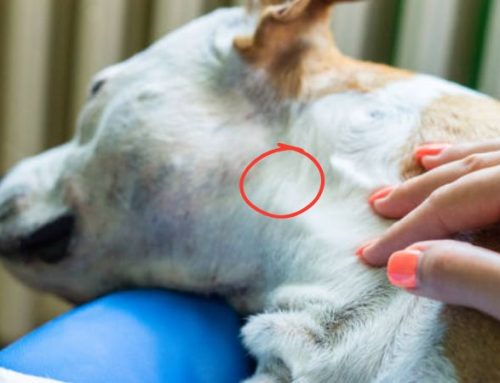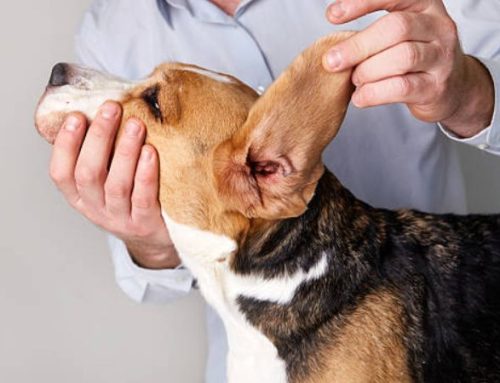If your cat has been shaking their head, pawing at their ears, or acting unusually irritable, they might be dealing with more than just a bad mood. Ear trouble specifically otitis externa is one of the most common issues vets see in felines, and it can turn even the sweetest kitty into a bundle of discomfort.
This condition, which affects the outer ear canal, can flare up suddenly or linger quietly for months, often triggered by everything from allergies to infections. In this guide from Nexus Pets, we’ll walk you through the key symptoms, common causes, and the safest home remedies to help your cat feel like themselves again.
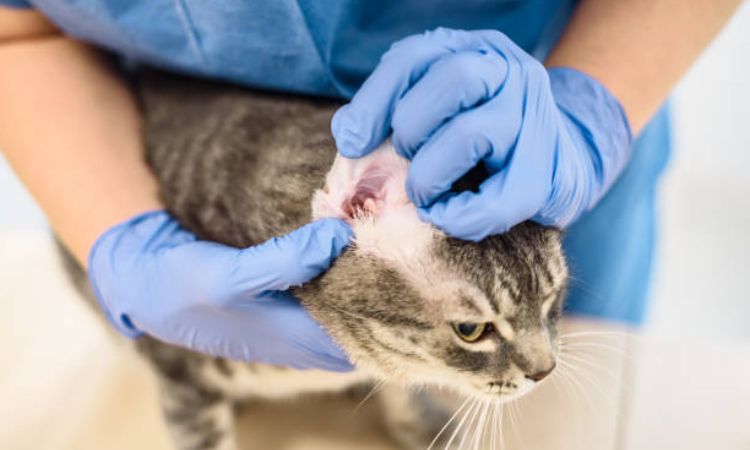
Common Symptoms of Cat Ear Infections
Ear infections in cats often start subtly, but the signs can become quite noticeable as inflammation or irritation worsens. Because the ear canal is sensitive and easily damaged, even mild infections can cause significant discomfort. Keep an eye out for the following symptoms, as they often indicate that something is wrong inside your cat’s ears:
- Pawing or scratching at the ears: Cats with irritated or painful ears may repeatedly scratch or rub at the affected side, sometimes causing scabs or hair loss around the pinna.
- Head shaking or tilting: Frequent shaking or holding the head at an angle is a common response to discomfort, inflammation, or pressure in the ear canal.
- Yellowish or black discharge: Discolored debris often signals infection. Black, gritty material is especially characteristic of ear mites, while yellow or brown discharge may point to bacterial or yeast overgrowth.
- Ear discharge resembling coffee grounds: This classic sign typically indicates ear mites, a common cause of feline otitis externa.
- Redness or swelling of the ear canal or ear flap: Inflamed tissue may appear bright red, puffy, or irritated. The pinna may feel warm to the touch.
- Foul odor from the ear: A sour, yeasty, or unpleasant smell is a strong indicator of infection and should never be ignored.
- Waxy buildup: Excessive wax can trap moisture and debris, creating the perfect environment for bacteria and yeast to thrive.
- Hearing loss, disorientation, or loss of balance: When infections extend deeper into the middle or inner ear, they may affect hearing or the vestibular system leading to unsteady walking, stumbling, or confusion.
Why Prompt Detection Matters
Catching an ear infection early is crucial for preventing long-term damage. Untreated infections can worsen quickly, spreading from the outer ear to the middle or inner ear, where vital structures responsible for hearing and balance are located. Left unchecked, this can lead to:
- Chronic, recurrent infections
- Persistent pain and inflammation
- Ear hematomas from excessive scratching
- Permanent hearing loss
- Serious balance or neurological problems
Early diagnosis not only makes treatment easier and more effective but also helps your cat avoid unnecessary discomfort. At the first sign of ear irritation or unusual behavior, a veterinary exam is the safest way to determine what’s going on and prevent complications.
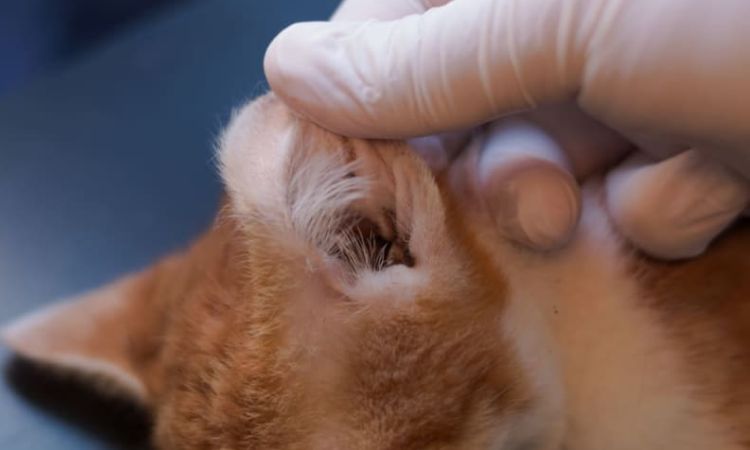
Main Causes of Cat Ear Infections
Ear infections in cats, medically referred to as otitis externa (outer ear infection) or otitis media (middle ear infection), can stem from a wide variety of causes. Unlike dogs, who are more prone to ear problems, cats are generally more resistant, so when a feline ear infection occurs, it’s often a sign of an underlying health issue. Understanding the root causes is crucial to preventing recurrence and ensuring proper treatment.
1. Ear Mites
Ear mites are tiny parasites that live in the ear canal and are one of the most common causes of ear infections in kittens and outdoor cats. They can spread easily between pets, and their presence often leads to intense itching, scratching, head shaking, and dark, coffee-ground–like discharge. Even after mites are eliminated, secondary bacterial or yeast infections can linger, worsening the condition.
2. Bacterial and Yeast Overgrowth
Bacteria and yeast are often secondary invaders that take advantage of a disrupted or weakened ear environment. Healthy ear canals can normally resist these microorganisms, but when the ear becomes irritated or damaged—due to allergies, moisture, or other conditions these pathogens can multiply rapidly, causing inflammation, pain, and discharge.
3. Allergies
Allergies are a frequent trigger for ear infections. Cats may react to certain foods, pollen, dust mites, or other environmental allergens. Allergic reactions often cause inflammation in the skin lining the ear canal, making it more vulnerable to bacterial or yeast overgrowth. Signs may include redness, swelling, and recurring ear problems that persist even after initial treatment.
4. Foreign Bodies
Foreign materials like grass awns, small seeds, or debris can lodge in a cat’s ear canal, irritating the delicate skin and creating an environment for infection. Foreign bodies often require veterinary intervention to remove and may cause persistent infections if left untreated.
5. Ear Canal Anatomy and Hair
Some cats have naturally narrow ear canals or dense hair within the canal, which can trap moisture and debris. This anatomical predisposition increases the risk of infections by creating a dark, warm environment where bacteria and yeast thrive. Breeds with folded ears, like Scottish Folds, are particularly susceptible.
6. Wax Buildup
Excessive ear wax (cerumen) can accumulate and block the ear canal, leading to bacterial or yeast infections. While some wax is normal and protective, overproduction—especially if combined with poor ear cleaning practices—can set the stage for an infection.
7. Tumors, Polyps, and Growths
Masses such as polyps or tumors inside the ear canal can obstruct normal airflow, trap debris, and promote chronic infections. These growths often require medical imaging, cytology, or surgical intervention for proper management.
8. Trauma or Improper Cleaning
Injuries to the ear or overly aggressive cleaning with inappropriate tools or solutions (like hydrogen peroxide or alcohol) can irritate the delicate skin of the ear canal. Damaged tissue is more prone to inflammation and secondary infections.
9. Chronic Medical Conditions
Underlying systemic illnesses can predispose cats to ear infections. Conditions like diabetes mellitus, immune-suppressing diseases (including FIV and FeLV), endocrine disorders (hypothyroidism or Cushing’s disease), and autoimmune diseases reduce the body’s ability to fight off infections, allowing ear inflammation to develop more easily.
10. Environmental Irritants
Dust, smoke, chemicals, or other environmental irritants can trigger inflammation in the ear canal. Cats with sensitive skin or preexisting conditions may be especially vulnerable to these triggers.
Professional Treatment Options
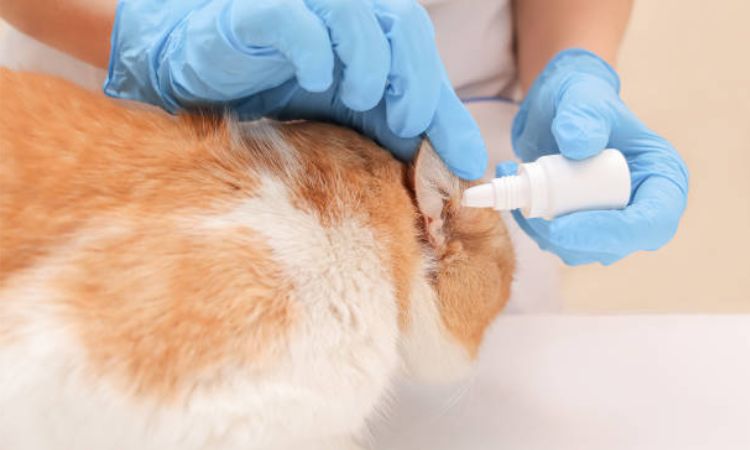
1. Topical and Oral Antibiotics/Antifungals
Ear infections in cats are frequently caused or complicated by bacterial or yeast overgrowth. Veterinarians typically prescribe topical medications such as ear drops or ointments that combine antibiotic, antifungal, and anti-inflammatory agents to treat the infection directly in the ear canal.
In cases where the infection has spread to the middle ear or if the cat is showing systemic symptoms, oral or injectable antibiotics or antifungals may be necessary. These treatments ensure that the infection is controlled throughout the ear structures and not just in the visible outer ear canal.
2. Anti-Parasitic Medications
Ear mites are one of the most common causes of otitis externa in cats, particularly in kittens and outdoor cats. Topical anti-parasitic medications, such as Revolution or similar formulations, are commonly prescribed to eliminate mites. Sometimes, the medication may be applied directly into the ear canal, while in other cases, it is applied systemically to treat any parasites that may have spread elsewhere on the body. Eliminating mites early is crucial to prevent secondary bacterial or yeast infections.
3. Corticosteroids for Inflammation
Inflammation of the ear canal can be extremely painful and contribute to swelling that narrows the ear passage. Corticosteroids either topical or oral are often used to reduce inflammation and pain. This is particularly important for cats with chronic or recurrent infections, where swelling can obstruct the canal and make cleaning or topical treatments more difficult. In some situations, corticosteroids may be combined with antibiotics and antifungals in a single ear drop formulation for maximum efficacy.
4. Professional Ear Cleaning
Proper ear cleaning is a critical part of treating and preventing recurrence of infections. Veterinarians can safely remove debris, wax, and discharge from the ear canal using specialized cleaning solutions and techniques. In more severe cases, where the ear is swollen, inflamed, or painful, professional cleaning may require sedation or anesthesia to prevent injury and ensure thorough treatment.
A key point is that over-the-counter or home ear cleaning attempts can sometimes do more harm than good if done incorrectly, potentially causing irritation, perforation of the eardrum, or further infection. Professional cleaning ensures that all debris is removed safely and sets the stage for medications to reach the deep parts of the ear canal where infections often persist.
5. When to See a Veterinarian vs. Treat at Home
While minor ear irritations or occasional wax buildup may seem manageable, any signs of persistent scratching, head shaking, discharge, foul odor, redness, swelling, or behavioral changes warrant a professional evaluation.
Home care can include gentle monitoring of the cat’s ears, administering prescribed medications exactly as directed, and following instructions for safe ear cleaning at home. However, home remedies alone are not sufficient for true infections, particularly those involving bacteria, yeast, or mites, or when there is suspicion of polyps, tumors, or ruptured eardrums.
Prompt veterinary attention is critical because untreated or poorly treated ear infections can become chronic, spread to the middle or inner ear, cause vestibular problems, hearing loss, and in severe cases, facial paralysis. Early intervention ensures a faster recovery, prevents complications, and reduces the likelihood of recurrent infections.
Best Home Remedies for Cat Ear Infections
While ear infections in cats usually require professional veterinary care, certain home remedies can help support treatment, alleviate mild discomfort, and prevent worsening—particularly when used as a complementary measure under veterinary guidance. It’s important to emphasize that home care should never replace a proper diagnosis, as untreated infections can become chronic, spread to the middle or inner ear, or even cause hearing loss and facial paralysis.
When Home Care May Help
Home remedies can be useful:
- For minor irritation or early signs of discomfort
- To help maintain ear hygiene after professional treatment
- As a supportive measure alongside vet-prescribed medications
They are not a substitute for antibiotics, antifungals, or anti-parasitics when an active infection is present.
Cat owners might be interested: Cat Ear Mites: How to Spot the Signs & Safely Treat Your Pet at Home
Evidence-Based Remedies
1. Diluted Apple Cider Vinegar (ACV)
Apple cider vinegar is sometimes used for its antimicrobial properties, which may help reduce bacterial or yeast growth in the outer ear.
How to use safely:
- Always dilute ACV with an equal part of water before applying
- Use a cotton ball or soft cloth to gently wipe the outer ear (never pour liquid deep into the ear canal)
- Frequency: Once daily or as recommended by a vet
- Caution: Do not use if the ear is raw, bleeding, or the eardrum is ruptured, as ACV can cause severe burning and irritation
2. Olive Oil for Cleaning Debris and Easing Mite Infestations
Olive oil can help soften wax and debris, making it easier to remove and reduce irritation. It may also help smother ear mites, though it is not a replacement for anti-parasitic medications.
How to use safely:
- Warm the olive oil slightly (body temperature)
- Apply a few drops onto a cotton ball, gently wipe the visible ear canal and pinna
- Do not insert anything deep into the ear canal
- Repeat only under vet supervision if debris persists
3. Yellow Dock Root for Inflammation
Yellow dock root has anti-inflammatory properties in herbal medicine. Some pet owners use it topically or as part of dietary supplementation to support healing.
Safety tips:
- Only use in small, controlled amounts, ideally as a tincture diluted per veterinary advice
- Avoid direct contact with the ear canal if the skin is broken or ulcerated
- Discuss with a vet before using herbal remedies, especially if your cat is on medications
4. Environmental Cleaning and Dietary Support
Supporting your cat’s environment and overall health can help reduce recurrence of ear infections:
- Regularly clean bedding, litter boxes, and areas your cat frequents to minimize exposure to mites or bacteria
- Maintain a balanced diet rich in essential fatty acids and antioxidants to support skin and immune health
- Identify and remove allergens (dust, pollen, or certain foods) that may trigger ear inflammation
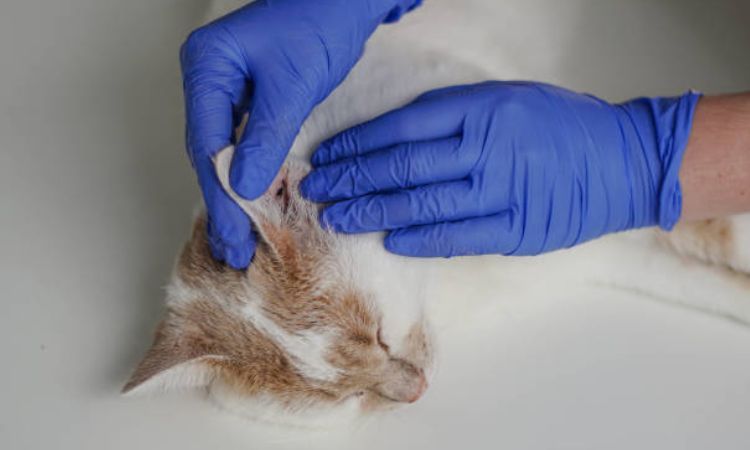
Cautions and When to Consult a Vet
Even safe home remedies have limitations. You should never rely solely on home care if your cat shows:
- Severe redness, swelling, or pus-like discharge
- Coffee-ground–like discharge (often indicates mites)
- Foul odor
- Head tilting, incoordination, or signs of pain
- Chronic or recurring ear problems
Using the wrong remedies, excessive cleaning, or inserting liquids deep into the ear canal can worsen infection, damage the eardrum, or cause long-term complications. Always consult a veterinarian before starting any home treatment.




